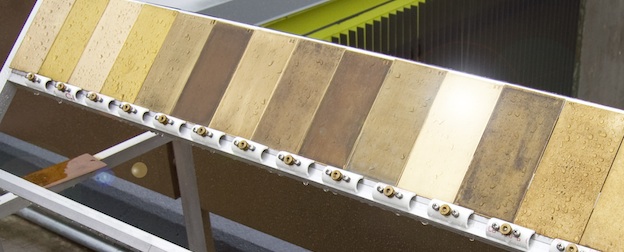Massive pieces of rare, historic metalwork on the exterior of the museum building – bronze window frames and sashes, large ornamental bronze window grilles and bronze light grilles, all designed by famous designer and glassmaker Louis Comfort Tiffany – needed to be restored.
Bronze Tiffany Light Grilles at PMA
Given the significance of the metalwork and the tremendous scope of the project, the museum wanted to use a durable, low-maintenance coating that could provide long-lasting protection against harsh outdoor conditions. Having been involved in the conservation of the iconic sculptures on top of Philadelphia’s City Hall, Arkema, a global chemicals manufacturer, was consulted to see if their coating solutions could help in the restoration process.
As the final step of the comprehensive restoration process, the coating technology from Arkema was applied to the Tiffany bronze grilles. The technology improves the ability of water-based coatings to withstand bright sunlight and harsh weather.
Close up of restored grilles
Seven years later and the coating is still looking good. Andrew Lins, Chairman of the Conservation Department at the Philadephia Museum of Art is delighted with the results. “The metalwork was restored to an appearance very close to what it looked like when it was made in the 1920s and the coating has required no maintenance whatsoever, which is a significant cost savings for us.”
Industry, Academia and Art Community Collaborate
The work on the Tiffany bronze grilles was the beginning of an ongoing collaboration between the Philadelphia Museum of Art, Arkema and academic scientist Tami Lasseter Clare, who had worked at the museum under a National Science Foundation grant and who now conducts coatings research as a faculty member at Portland State University. Decreases in maintenance budgets and increases in government restrictions on volatile organic compound (VOC) emissions and solvent use makes the continued study of water-based coatings for outdoor sculptures, monuments and high-value architectural metalwork tremendously important to conservators.

Outdoor Weathering Rack
The Rodin Museum, which is administered by the Philadelphia Museum of Art, used this particular latex-based coating on its bronze window grilles as well as on two prominent outdoor Auguste Rodin sculptures — “The Age of Bronze” and “Eve.” Andrew Lins again, “It’s been about a year since the sculptures were finished, and they are doing nicely. I think that the Kynar Aquatec latex can be used with proper care to application and get the longevity results that people hope for.”
Arkema is continuing to enhance water-based coatings that protect the artwork against bright sunlight, harsh weather conditions and pollution to ensure that the artwork not only looks as it was intended, but is well-preserved after restoration work is done. While the coating is used primarily for industrial and residential paints and coatings, its chemical properties show promise in meeting the needs of the art conservation community. These high-performance, environmentally sustainable coating systems have the potential to save museums time and money whilst also improving their carbon footprint. The coatings do not significantly fade or discolour for decades, help to ensure that surfaces resist mildew as well as scratches, repel water, pick up very little dirt, and are extremely sturdy. Because the technology does not require baking at high temperatures, it can be applied in the field rather than being limited to factory-application.
There is an ongoing collaboration between conservators, academia and the manufacturers, Arkema, to enhance the coating technology for improved performance on a broader range of surface conditions. Partners are evaluating how water-based coatings can be applied to control gloss and colour effectively in every situation.
Back to top




